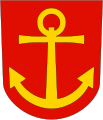Narvik
Narvik Municipality
Narvik kommune | |
|---|---|
 View of Narvik | |
|
| |
| Nicknames: By1, Victoria Havn | |
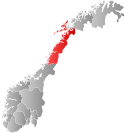 Nordland within Norway | |
 Narvik within Nordland | |
| Coordinates:68°25′14″N17°33′36″E/ 68.42056°N 17.56000°E | |
| Country | Norway |
| County | Nordland |
| District | Ofoten |
| Established | 1 Jan 1902 |
| •Preceded by | Ankenes Municipality |
| Administrative centre | Narvik |
| Government | |
| • Mayor(2015) | Rune Edvardsen (Ap) |
| Area | |
| • Total | 3,432.20 km2(1,325.18 sq mi) |
| • Land | 3,194.68 km2(1,233.47 sq mi) |
| • Water | 237.52 km2(91.71 sq mi) 6.9% |
| • Rank | #10 in Norway |
| Population (2023) | |
| • Total | 21,515 |
| • Rank | #58 in Norway |
| • Density | 6.7/km2(17/sq mi) |
| • Change(10 years) | |
| Demonyms | Narvikværing Narviking[1] |
| Official language | |
| •Norwegian form | Neutral |
| Time zone | UTC+01:00(CET) |
| • Summer (DST) | UTC+02:00(CEST) |
| ISO 3166 code | NO-1806[3] |
| Website | Official website |
Narvik(;Northern Sami:Áhkanjárga[4]) is the third-largestmunicipalityinNordlandcounty,Norway,by population. Theadministrative centreof the municipality is thetown of Narvik.Some of the notable villages in the municipality includeAnkenesstranda,Ballangen,Beisfjord,Bjerkvik,Bjørnfjell,Elvegård,Kjøpsvik,Skjomen,Håkvik,Hergot,Straumsnes,andVidrek.TheElvegårdsmoenarmy camp is located near Bjerkvik.
Narvik is located on the shores of theOfotfjorden.The municipality is part of thetraditional districtofOfotenofNorthern Norway,inside theArctic Circle.The municipality of Narvik borders the municipality ofHamarøyto the southwest,Evenesto the northwest,Bardu,Gratangen,LavangenandTjeldsund(inTromscounty) to the north, andNorrbotten County(Lapland) inSwedento the south and east.
The 3,432-square-kilometre (1,325 sq mi) municipality is the 10th largest by area out of the 356 municipalities in Norway. Narvik is the 58th most populous municipality in Norway with a population of 21,515. The municipality'spopulation densityis 6.7 inhabitants per square kilometre (17/sq mi) and its population has decreased by 2.2% over the previous 10-year period.[5][6]
General information[edit]
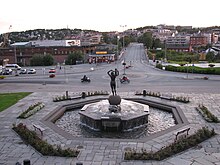
The municipality of Narvik was established on 1 January 1902 when the village of Narvik received status as a proper town and was separated from the large municipality ofAnkenes.Initially, the town-municipality of Narvik had 3,705 residents. On 1 January 1974, the municipality ofAnkeneswas merged with the town-municipality of Narvik, forming a new, larger municipality of Narvik. After the merger, the new municipality of Narvik had 19,780 residents. On 1 January 1999, a small area of Narvik Municipality (population: 9) was transferred to the neighboringEvenes Municipality.[7][8]
On 1 January 2020, the municipality of Narvik was merged with the neighboringBallangen Municipalityand the eastern half ofTysfjord Municipalityto form a new, larger municipality of Narvik. This occurred because in 2017, the municipal government agreed to the merger and theParliament of Norwayrequired Tysfjord to be split up.[9]
Coat of arms[edit]
Thecoat of armswas adopted on 20 June 2019 for use starting on 1 January 2020 after a municipal merger. Theblazonis"Azure,a mountain peakargent".This means the arms have a bluefield(background) and thechargeis a mountain peak. The mountain peak has atinctureofargentwhich means it is commonly colored white, but if it is made out of metal, then silver is used. The arms were designed to look like the local mountainStetind.The arms were designed by Eirik Djupvik.[10][11]
Thecoat of armswas granted on 1 June 1951 and they were in use until 1 January 2020 when there was a municipal merger. The officialblazonis"Gules,an anchorOr"(Norwegian:På rød bunn et opprett gull anker). This means the arms have a redfield(background) and thechargeis ananchor.The anchor has atinctureofOrwhich means it is commonly colored yellow, but if it is made out of metal, then gold is used. The anchor symbolises Narvik's status as an importantport(the largestharbourin North Norway). The arms were designed byHallvard Trætteberg.[10][12][13]
-
Current arms since 2020
-
Arms (1951-2019)
Name[edit]
The municipality (originally thetown of Narvik) is named after the oldNarvikfarm (Old Norse:KnarravíkorNjarðarvík) since the town was built there. The two possible Old Norse roots have differing meanings. If it comes fromKnarravík,then the meaning of the first element is thegenitiveplural form ofknǫrrorknarrwhich means "merchant ship". The other option is that the name is derived fromNjarðarvík.In that case, the first element comes from the old pagan god nameNjǫrðr.Both options share the same last element,vík,which means "inlet".Historically, the name was spelledNarduighorNarvigen.[14]
The harbour in thetown of Narvikwas once calledVictoriahavnafterQueen Victoriaof the United Kingdom, however Sweden'sCrown Princess Victoriawas also honoured.[15]

History[edit]
The history of Narvik as a settlement began in theBronze Age.Not very much is known about these people, but theVikingslived in this area.

Narvik was developed as an all-yearice free portfor the Swedish Kiruna andGällivareironmines.The history of modern Narvik begins in the 1870s, when theSwedish governmentbegan to understand the potential of theiron oremines inKiruna,Sweden. Obtaining iron ore from Kiruna had one significant problem in that there was no suitable Swedish port. The nearest Swedish port,Luleå,had limitations. It was covered with ice all winter, it is far from Kiruna, and it allows only medium-sized bulk freight vessels. Narvik offered a port which is ice-free thanks to the warmGulf Stream,and is naturally large, allowing boats of virtually any size to anchor, up to 208 metres (682 ft) long and 27 metres (89 ft) deep.[15][16]The Swedish company(Gällivarre Aktiebolag)built theIron Ore Line(Malmbanan) toRiksgränsenon the Norway–Sweden border. The NorwegianOfotbanenrailway line connects Narvik to the Swedish border.
Swedish mining corporationLKABstill ships the majority of its ore from Narvik (a total 25 million tons a year). It is an important employer and landowner in Narvik, although its influence is not as prominent as in the past.[16]
World War II[edit]

(Borders as of 1920–1940.)
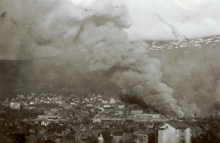

The port of Narvik proved to be strategically valuable in the early years ofWorld War IIandthe townbecame a focal point of theNorwegian Campaign.In 1939, Germany's war industry depended upon iron ore mined in Kiruna and Malmberget in Sweden. During the summer season, this ore could be sent by cargo ship to Germany through theBaltic Seavia the Swedish port of Luleå on theGulf of Bothnia.However, when the Gulf of Bothnia froze during the winter, more shipments of the ore needed to be transported through Narvik and, from there, down the west coast of Norway to Germany. The town of Narvik is linked by rail to Sweden, but not to any other towns in Norway. As a result, Narvik serves as a gateway to the ore fields of Sweden that cannot be easily reached from southern Norway via land.Winston Churchillrealized that the control of Narvik meant stopping most German imports of iron ore during the winter of 1940. This would be advantageous to the Allies, and it might help shorten the war. Equally as important, later in the war, German submarines and warships based there threatened the allied supply line to theSoviet Union.[17]
Churchill proposed laying anaval minefieldin Norwegian territorial waters around Narvik (referred to as "the Leads" ),[17]or else occupying the town with Allied troops. The Allies hoped that they might be able to use an occupied Narvik as a base from which to secure the Swedish ore fields and/or to send supplies and reinforcements toFinland,then fighting the FinnishWinter Warwith the Soviet Union. Plans to lay a minefield around Narvik or to seize the town met with debate within the British government – since both plans would mean a violation of Norway's neutrality and sovereignty.[17]
Finally, on 8 April 1940, the British Admiralty launchedOperation Wilfred,an attempt to lay anti-shipping minefields around Narvik in Norwegian territorial waters. Coincidentally, Germany launched its invasion of Norway (Operation Weserübung) on the next day. During this invasion, ten Germandestroyers,each carrying 200 mountain infantry soldiers, were sent to Narvik. The outdated Norwegiancoastal defence shipsHNoMSEidsvoldandHNoMSNorgeattempted to resist the invasion, but both Norwegian warships were sunk after a short and uneven battle. TheRoyal Navyquickly dispatched several ships to Narvik, including the battleshipHMSWarspite,and during theBattles of Narvik,the British took control of the coast, destroying the German destroyers that had brought the invasion force to Narvik, as well as other German ships in the area.
On 12 April 1940, the first convoys of Allied soldiers were sent under Major-GeneralPierse Joseph Mackesyto Narvik. The Admiralty urged Mackesy to conduct an assault on Narvik from the sea as soon as possible. However, Mackesy believed that the German harbour defences were too strong for such an invasion to take place. The Admiralty argued that a naval bombardment of Norway would enable the troops to land safely, but General Mackesy refused to subject Norwegian citizens to such a bombardment, and instead he chose to land his troops near Narvik and wait until the snow melted to take over the town.[17]
Coordinated by the NorwegianGeneralCarl Gustav Fleischer,Norwegian, French, Polish, and British forces recaptured Narvik on 28 May 1940. This is also considered the first Allied infantry victory in World War II. However, by that time, the Allies were losing theBattle of Franceand theevacuation from Dunkirkwas underway. Since theNazi Germaninvasion of France had made Scandinavia largely irrelevant, and since the valuable troops assigned to Narvik were badly needed elsewhere, the Allies withdrew from Narvik on 8 June 1940 inOperation Alphabet.The same day,while operating in the Narvik area,the German battleshipsScharnhorstandGneisenausank the British aircraft carrierHMSGloriousduring the withdrawal from this battle.[18]Without support from the Allied naval task force, the Norwegians were outnumbered, and they had to lay down their arms in Norway on 10 June 1940. This was not a complete capitulation, since the Norwegians kept on fightingguerrillaoperations inland.
Possession of theOfotfjordwas also important to the GermanKriegsmarine(navy) since it provided a refuge for warships like the "pocket battleship"Lützowand the battleshipTirpitzoutside the range (at the time) of air attacks fromScotland.Also, possiblyU-boatscould be based at Narvik.
Government[edit]
The municipality is responsible forprimary education(through 10th grade), outpatienthealth services,senior citizenservices,welfareand othersocial services,zoning,economic development,and municipalroadsand utilities. The municipality is governed by amunicipal councilofdirectly electedrepresentatives. Themayorisindirectly electedby a vote of the municipal council.[19]The municipality is under the jurisdiction of theMidtre Hålogaland District Courtand theHålogaland Court of Appeal.
Municipal council[edit]
Themunicipal council(Kommunestyre)of Narvik is made up of 31 representatives that are elected to four year terms. The tables below show the current and historical composition of the council by politicalparty.
| Party name(in Norwegian) | Number of representatives | |
|---|---|---|
| Labour Party(Arbeiderpartiet) | 8 | |
| Progress Party(Fremskrittspartiet) | 4 | |
| Conservative Party(Høyre) | 7 | |
| Industry and Business Party(Industri‑ og Næringspartiet) | 4 | |
| Christian Democratic Party(Kristelig Folkeparti) | 1 | |
| Red Party(Rødt) | 1 | |
| Centre Party(Senterpartiet) | 3 | |
| Socialist Left Party(Sosialistisk Venstreparti) | 3 | |
| Total number of members: | 31 | |
| Party name(in Norwegian) | Number of representatives | |
|---|---|---|
| Labour Party(Arbeiderpartiet) | 15 | |
| Progress Party(Fremskrittspartiet) | 4 | |
| Green Party(Miljøpartiet De Grønne) | 2 | |
| Conservative Party(Høyre) | 5 | |
| Christian Democratic Party(Kristelig Folkeparti) | 1 | |
| Red Party(Rødt) | 1 | |
| Centre Party(Senterpartiet) | 9 | |
| Socialist Left Party(Sosialistisk Venstreparti) | 4 | |
| Total number of members: | 41 | |
| Party name(in Norwegian) | Number of representatives | |
|---|---|---|
| Labour Party(Arbeiderpartiet) | 13 | |
| Progress Party(Fremskrittspartiet) | 4 | |
| Green Party(Miljøpartiet De Grønne) | 2 | |
| Conservative Party(Høyre) | 12 | |
| Christian Democratic Party(Kristelig Folkeparti) | 1 | |
| Red Party(Rødt) | 2 | |
| Socialist Left Party(Sosialistisk Venstreparti) | 6 | |
| Liberal Party(Venstre) | 1 | |
| Total number of members: | 41 | |
| Party name(in Norwegian) | Number of representatives | |
|---|---|---|
| Labour Party(Arbeiderpartiet) | 15 | |
| Progress Party(Fremskrittspartiet) | 9 | |
| Conservative Party(Høyre) | 10 | |
| Christian Democratic Party(Kristelig Folkeparti) | 1 | |
| Red Party(Rødt) | 2 | |
| Socialist Left Party(Sosialistisk Venstreparti) | 2 | |
| Liberal Party(Venstre) | 2 | |
| Total number of members: | 41 | |
| Party name(in Norwegian) | Number of representatives | |
|---|---|---|
| Labour Party(Arbeiderpartiet) | 14 | |
| Progress Party(Fremskrittspartiet) | 13 | |
| Conservative Party(Høyre) | 5 | |
| Christian Democratic Party(Kristelig Folkeparti) | 2 | |
| Centre Party(Senterpartiet) | 1 | |
| Socialist Left Party(Sosialistisk Venstreparti) | 5 | |
| Liberal Party(Venstre) | 1 | |
| Total number of members: | 41 | |
| Party name(in Norwegian) | Number of representatives | |
|---|---|---|
| Labour Party(Arbeiderpartiet) | 14 | |
| Progress Party(Fremskrittspartiet) | 9 | |
| Conservative Party(Høyre) | 6 | |
| Christian Democratic Party(Kristelig Folkeparti) | 2 | |
| Centre Party(Senterpartiet) | 1 | |
| Socialist Left Party(Sosialistisk Venstreparti) | 8 | |
| Liberal Party(Venstre) | 1 | |
| Total number of members: | 41 | |
| Party name(in Norwegian) | Number of representatives | |
|---|---|---|
| Labour Party(Arbeiderpartiet) | 16 | |
| Progress Party(Fremskrittspartiet) | 5 | |
| Conservative Party(Høyre) | 9 | |
| Christian Democratic Party(Kristelig Folkeparti) | 3 | |
| Centre Party(Senterpartiet) | 2 | |
| Socialist Left Party(Sosialistisk Venstreparti) | 5 | |
| Liberal Party(Venstre) | 1 | |
| Total number of members: | 41 | |
| Party name(in Norwegian) | Number of representatives | |
|---|---|---|
| Labour Party(Arbeiderpartiet) | 23 | |
| Progress Party(Fremskrittspartiet) | 5 | |
| Conservative Party(Høyre) | 9 | |
| Christian Democratic Party(Kristelig Folkeparti) | 3 | |
| Centre Party(Senterpartiet) | 5 | |
| Socialist Left Party(Sosialistisk Venstreparti) | 5 | |
| Liberal Party(Venstre) | 1 | |
| Joint list of the Left/Socialists Electoral Union andCommunist Party(Venstresosialistenes Valgforbund og Kommunistiske Parti) | 2 | |
| Total number of members: | 53 | |
| Party name(in Norwegian) | Number of representatives | |
|---|---|---|
| Labour Party(Arbeiderpartiet) | 25 | |
| Progress Party(Fremskrittspartiet) | 2 | |
| Conservative Party(Høyre) | 9 | |
| Christian Democratic Party(Kristelig Folkeparti) | 2 | |
| Centre Party(Senterpartiet) | 4 | |
| Socialist Left Party(Sosialistisk Venstreparti) | 9 | |
| Liberal Party(Venstre) | 1 | |
| Left/Socialists Electoral Union(Venstresosialistenes Valgforbun) | 1 | |
| Total number of members: | 53 | |
| Party name(in Norwegian) | Number of representatives | |
|---|---|---|
| Labour Party(Arbeiderpartiet) | 26 | |
| Conservative Party(Høyre) | 14 | |
| Christian Democratic Party(Kristelig Folkeparti) | 2 | |
| Centre Party(Senterpartiet) | 2 | |
| Socialist Left Party(Sosialistisk Venstreparti) | 6 | |
| Liberal Party(Venstre) | 2 | |
| Joint list of the Left/Socialists Electoral Union andCommunist Party(Venstresosialistenes Valgforbund og Kommunistiske Parti) | 1 | |
| Total number of members: | 53 | |
| Party name(in Norwegian) | Number of representatives | |
|---|---|---|
| Labour Party(Arbeiderpartiet) | 31 | |
| Conservative Party(Høyre) | 17 | |
| Christian Democratic Party(Kristelig Folkeparti) | 2 | |
| Centre Party(Senterpartiet) | 3 | |
| Socialist Left Party(Sosialistisk Venstreparti) | 5 | |
| Liberal Party(Venstre) | 2 | |
| Joint list of the Left/Socialists Electoral Union andCommunist Party(Venstresosialistenes Valgforbund og Kommunistiske Parti) | 1 | |
| Total number of members: | 61 | |
| Party name(in Norwegian) | Number of representatives | |
|---|---|---|
| Labour Party(Arbeiderpartiet) | 28 | |
| Conservative Party(Høyre) | 19 | |
| Christian Democratic Party(Kristelig Folkeparti) | 3 | |
| Centre Party(Senterpartiet) | 3 | |
| Socialist Left Party(Sosialistisk Venstreparti) | 3 | |
| Liberal Party(Venstre) | 4 | |
| Joint list of Independent socialists andCommunist Party(Uavhengige sosialister og Norges Kommunistiske Part) | 1 | |
| Total number of members: | 61 | |
| Party name(in Norwegian) | Number of representatives | |
|---|---|---|
| Labour Party(Arbeiderpartiet) | 31 | |
| Conservative Party(Høyre) | 12 | |
| Christian Democratic Party(Kristelig Folkeparti) | 4 | |
| New People's Party(Nye Folkepartiet) | 2 | |
| Centre Party(Senterpartiet) | 4 | |
| Socialist Left Party(Sosialistisk Venstreparti) | 6 | |
| Liberal Party(Venstre) | 2 | |
| Total number of members: | 61 | |
| Party name(in Norwegian) | Number of representatives | |
|---|---|---|
| Labour Party(Arbeiderpartiet) | 29 | |
| Conservative Party(Høyre) | 10 | |
| Christian Democratic Party(Kristelig Folkeparti) | 2 | |
| Centre Party(Senterpartiet) | 2 | |
| Socialist People's Party(Sosialistisk Folkeparti) | 3 | |
| Liberal Party(Venstre) | 3 | |
| Socialist common list (Venstresosialistiske felleslister) | 4 | |
| Total number of members: | 53 | |
| Party name(in Norwegian) | Number of representatives | |
|---|---|---|
| Labour Party(Arbeiderpartiet) | 28 | |
| Conservative Party(Høyre) | 11 | |
| Communist Party(Kommunistiske Parti) | 2 | |
| Christian Democratic Party(Kristelig Folkeparti) | 1 | |
| Socialist People's Party(Sosialistisk Folkeparti) | 5 | |
| Liberal Party(Venstre) | 6 | |
| Total number of members: | 53 | |
| Party name(in Norwegian) | Number of representatives | |
|---|---|---|
| Labour Party(Arbeiderpartiet) | 28 | |
| Conservative Party(Høyre) | 12 | |
| Communist Party(Kommunistiske Parti) | 2 | |
| Christian Democratic Party(Kristelig Folkeparti) | 1 | |
| Socialist People's Party(Sosialistisk Folkeparti) | 5 | |
| Liberal Party(Venstre) | 5 | |
| Total number of members: | 53 | |
| Party name(in Norwegian) | Number of representatives | |
|---|---|---|
| Labour Party(Arbeiderpartiet) | 28 | |
| Conservative Party(Høyre) | 12 | |
| Communist Party(Kommunistiske Parti) | 4 | |
| Christian Democratic Party(Kristelig Folkeparti) | 4 | |
| Liberal Party(Venstre) | 5 | |
| Total number of members: | 53 | |
| Party name(in Norwegian) | Number of representatives | |
|---|---|---|
| Labour Party(Arbeiderpartiet) | 30 | |
| Conservative Party(Høyre) | 9 | |
| Communist Party(Kommunistiske Parti) | 6 | |
| Christian Democratic Party(Kristelig Folkeparti) | 4 | |
| Liberal Party(Venstre) | 4 | |
| Total number of members: | 53 | |
| Party name(in Norwegian) | Number of representatives | |
|---|---|---|
| Labour Party(Arbeiderpartiet) | 26 | |
| Conservative Party(Høyre) | 11 | |
| Communist Party(Kommunistiske Parti) | 8 | |
| Christian Democratic Party(Kristelig Folkeparti) | 3 | |
| Liberal Party(Venstre) | 4 | |
| Total number of members: | 52 | |
| Party name(in Norwegian) | Number of representatives | |
|---|---|---|
| Labour Party(Arbeiderpartiet) | 19 | |
| Conservative Party(Høyre) | 10 | |
| Communist Party(Kommunistiske Parti) | 10 | |
| Liberal Party(Venstre) | 5 | |
| Total number of members: | 44 | |
| Party name(in Norwegian) | Number of representatives | |
|---|---|---|
| Labour Party(Arbeiderpartiet) | 17 | |
| Conservative Party(Høyre) | 9 | |
| Communist Party(Kommunistiske Parti) | 13 | |
| Liberal Party(Venstre) | 5 | |
| Total number of members: | 44 | |
| Party name(in Norwegian) | Number of representatives | |
|---|---|---|
| Labour Party(Arbeiderpartiet) | 23 | |
| Conservative Party(Høyre) | 11 | |
| Liberal Party(Venstre) | 3 | |
| List of workers, fishermen, and small farmholders(Arbeidere, fiskere, småbrukere liste) | 6 | |
| Local List(s)(Lokale lister) | 1 | |
| Total number of members: | 44 | |
| Note:Due to theGerman occupation of NorwayduringWorld War II,no elections were held for new municipal councils until after the war ended in 1945. | ||
Mayors[edit]
- 1902–1902: Ole Martinussen
- 1903–1903:Nils Astrup
- 1904–1904: Statius Mosling
- 1905–1905: Ole Martinussen
- 1906–1907: Statius Mosling
- 1908–1908: Edvard Kristiansen
- 1909–1910: Karl Kristian Høiem
- 1911–1911:Rolf Jacobsen(V)
- 1912–1913: Albert Zintzen
- 1914–1921:Julius Bastian Olsen(Ap)
- 1922–1922: Einar Wexelsen (V)
- 1923–1927:Julius Bastian Olsen(Ap)
- 1929–1930: Hans Kisen (Ap)
- 1934–1940:Theodor Broch(Ap)
- 1940-1945:Occupation of Norway by Nazi Germany
- 1945–1945:Theodor Broch(Ap)
- 1945–1949: Alfred Nilsen (Ap)
- 1949–1953: Odd Finseth (Ap)
- 1953–1967: Sverre Øvergård (Ap)
- 1968–1973: Arne Kristian Meedby (Ap)
- 1974–1979: Edgar Sneve (Ap)
- 1980–1987: Roald Sandvoll (Ap)
- 1988–1999: Odd G. Andreassen (Ap)
- 2000–2007: Olav Sigurd Alstad (Ap)
- 2007–2011:Karen Margrethe Kuvaas(Ap)
- 2011–2015: Tore Nysæter (H)
- 2015–present: Rune Edvardsen (Ap)
Geography[edit]
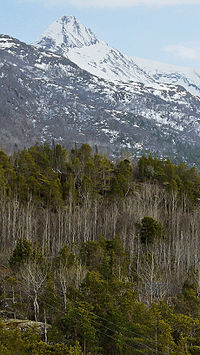
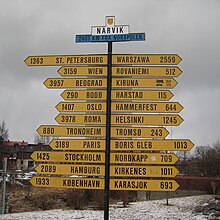
The municipality of Narvik covers large areas outside the town itself. Some of the other settlements in the municipality areBjerkvik(located at the head of theHerjangsfjord),Håkvik,Beisfjord(along theBeisfjorden) andSkjomen.The eastern part, towards the border with Sweden, is dominated by mountains, andStorsteinfjelletreaches 1,894 metres (6,214 ft). There are also valleys and lakes, including the lakesGautelisvatnet,Hartvikvatnet,Indre Sildvikvatnet,Iptojávri,Kjårdavatnet,Lossivatnet,SealggajávriandUnna Guovdelisjávri.
The town itself is situated near the innermost part of the deepOfotfjorden,but even here the mountains, going almost straight up from the bluefjord,reach as high as 1,700 metres (5,600 ft) inSkjomen,where theglacierFrostisencan be seen. Other fjords in Narvik includeSkjomen,Beisfjorden,Herjangsfjorden,andRombaken.
Forestscover the lower parts of the mountains (below 500 metres), but near the summits, thesnowcan stay most of the summer. Narvik has well prepared slopes foralpine skiing,some of which end almost in the town centre.
Climate[edit]
Narvik features aboreal climate(Köppen climate classification:Dfc) with mild winters for this climate type, or a subpolar oceanic climate (Cfc), depending on winter threshold (0 °C (32 °F) as used in the US or −3 °C (27 °F) as in the originalclassification). It is close to a humid continental climate due to a mild September. As Narvik is 220 kilometres (140 mi) inside theArctic Circle,the climate is very mild for the latitude. The mountains surrounding the town give shelter from some of the strong winds typical for coastal areas, but the easterlies can be strong with especially strong wind gusts. The all-time high 32.5 °C (90.5 °F) was set 9 July 2014. July 2014 is warmest month on record with mean 18.7 °C (65.7 °F) and average daily high 24.7 °C (76.5 °F). The all-time low −22.3 °C (−8.1 °F) was recorded on 1 February 1980. Coldest month on record is February 1966 with mean −10.7 °C (12.7 °F) and average daily low −13.2 °C (8.2 °F). The average date for the first overnight freeze in autumn when the low goes below −0 °C (32 °F) is October 13 (1981-2010).[40]

The light varies considerably in Narvik since the sun is below thehorizonfrom late November until mid-January; when there is only a bluish light for a few hours aroundnoon.[41]The mountains surrounding the town in reality extend this period from early November until the end of January. The light is often intense in March and April, with long daylight hours and snow cover since the snow melts in lowland areas in April, but stays in the mountains for several months. The "midnight sun"is above the horizon from 25 May to 20 July (57 days), and the period with continuous daylight lasts a bit longer, from approximately 10 May to the end of July,polar nightfrom 5 December to 6 January (33 days). There is also a transitional period with twilight in the night, so it is not possible to see any stars at night from the last days of April until early August.
| Climate data for Narvik Airport 1991–2020 (31 m, precipitation Narvik III, extremes 1954-2020 includes earlier stations) | |||||||||||||
|---|---|---|---|---|---|---|---|---|---|---|---|---|---|
| Month | Jan | Feb | Mar | Apr | May | Jun | Jul | Aug | Sep | Oct | Nov | Dec | Year |
| Record high °C (°F) | 11.5 (52.7) |
9 (48) |
12.5 (54.5) |
20.4 (68.7) |
29.9 (85.8) |
30 (86) |
32.5 (90.5) |
28.6 (83.5) |
27.2 (81.0) |
19.6 (67.3) |
15.8 (60.4) |
11.4 (52.5) |
32.5 (90.5) |
| Daily mean °C (°F) | −2.3 (27.9) |
−2.7 (27.1) |
−0.8 (30.6) |
2.9 (37.2) |
7.4 (45.3) |
11.4 (52.5) |
14.5 (58.1) |
13.5 (56.3) |
9.4 (48.9) |
4.5 (40.1) |
1.2 (34.2) |
−0.8 (30.6) |
4.9 (40.7) |
| Record low °C (°F) | −20 (−4) |
−22.3 (−8.1) |
−15.7 (3.7) |
−11.8 (10.8) |
−5 (23) |
−1 (30) |
4.5 (40.1) |
0.5 (32.9) |
−3.5 (25.7) |
−11.1 (12.0) |
−13.6 (7.5) |
−19 (−2) |
−22.3 (−8.1) |
| Averageprecipitationmm (inches) | 108 (4.3) |
98 (3.9) |
82 (3.2) |
44 (1.7) |
56 (2.2) |
57 (2.2) |
88 (3.5) |
91 (3.6) |
107 (4.2) |
107 (4.2) |
99 (3.9) |
97 (3.8) |
1,034 (40.7) |
| Source: Norwegian Meteorological Institute[42] | |||||||||||||
| Climate data for Narvik (1961–90) | |||||||||||||
|---|---|---|---|---|---|---|---|---|---|---|---|---|---|
| Month | Jan | Feb | Mar | Apr | May | Jun | Jul | Aug | Sep | Oct | Nov | Dec | Year |
| Mean daily maximum °C (°F) | −2 (28) |
−2 (28) |
1 (34) |
5 (41) |
9 (48) |
14 (57) |
18 (64) |
16 (61) |
12 (54) |
6 (43) |
3 (37) |
−1 (30) |
7 (44) |
| Daily mean °C (°F) | −4.1 (24.6) |
−3.9 (25.0) |
−2 (28) |
1.8 (35.2) |
6.9 (44.4) |
10.9 (51.6) |
13.4 (56.1) |
12.5 (54.5) |
8.4 (47.1) |
4.2 (39.6) |
−0.2 (31.6) |
−2.7 (27.1) |
3.8 (38.8) |
| Mean daily minimum °C (°F) | −7 (19) |
−7 (19) |
−5 (23) |
−2 (28) |
3 (37) |
7 (45) |
11 (52) |
10 (50) |
6 (43) |
2 (36) |
−2 (28) |
−5 (23) |
1 (34) |
| Averageprecipitationmm (inches) | 69 (2.7) |
64 (2.5) |
49 (1.9) |
44 (1.7) |
40 (1.6) |
53 (2.1) |
74 (2.9) |
82 (3.2) |
92 (3.6) |
110 (4.3) |
75 (3.0) |
78 (3.1) |
830 (32.7) |
| Average precipitation days(≥ 1mm) | 10.6 | 10.2 | 8.8 | 9.1 | 9.2 | 12.4 | 14.7 | 14.0 | 15.1 | 14.5 | 11.1 | 12.2 | 141.9 |
| Source: Norwegian Meteorological Institute – eKlima portal[43] | |||||||||||||
Economy[edit]
Thetown of Narvikis a commercial centre for some of the neighbouring municipalities.Narvik University Collegehas approximately 1,200 students. There are some high-tech businesses in Narvik (among themNatech) and the largest research institute in Northern Norway,Norut Narvik.
Narvik was one of the first areas in the world to be affected by thefinancial crisis of 2007–2008.It lost the equivalent of US$36 million in August 2007 after it invested inCitigroupsecurities.[44]As the Norwegian government refused to bail them out, Narvik was forced to implement severe budget cuts.[44]
Recreation and tourism[edit]

Narvik has access to numerous outdoor activities. This is the best known location in northern Norway for alpine skiing.[45]

There are lifts, and several of the slopes are floodlit. There is also acable carto Fagernesfjellet, with a view and the possibility to walk even higher up in the mountains. Narvik Winter Festival (Norwegian:Vinterfestuka) takes place in early March. Mountainhikingis very popular in the area, and the mountain area near the Swedish border has several places of accommodation. A signed mountain bike route is also available.Wreck divingattracts divers to Narvik, as there are a lot of wrecks in or near the harbour, and more spread out in the fjord. Fishing in the fjord or in lakes and streams is a popular leisure activity. There aresalmonrivers in Skjomen, Beisfjord and Bjerkvik.
Transportation[edit]

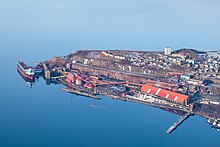

Port[edit]
The port of Narvik is ice-free and well protected from the weather. The port consists of three waterfront sections: LKAB bulk port, central port area with piers and deep-water harbor at Fagernes with intermodal facilities. Approximately 16,000,000 tonnes (16,000,000 long tons; 18,000,000 short tons) of cargo are annually shipped from the ports of Narvik. By 2015, the port had handled 1.1 billion tonnes of ore. Most of this iron ore. In 2015 the port installed a pier with 18suction cupstomoorships, expected to save 40 minutes of mooring time. Each cup is 2x2 meters.[46]
Port Authorities have initiated an expansion of the container area of approximately 45,000 square metres (11 acres), which is more than twice what Norway's largest terminal in Oslo today handles. In 2005, the port of Narvik got status asMotorways of the Seain the EU-system. In Norway, Oslo is the only city which has this status in addition to the town of Narvik.
Rail[edit]
A present and historical key to land transportation to Narvik is theOfoten Linerailway from northern Sweden across the mountains to this port town. Goods like iron ore shipped via this railroad make Narvik an important seaport. The railway has stops atBjørnfjell Station,Katterat Station,Søsterbekk Station,andNarvik Station.
Because of the extreme terrain there, there are no railways northwards from Narvik or south toBodø,Norway, which is at the northern end of the rest of Norway's rail network. However, it is possible to reach Narvik by way of an approximately twenty-hour 1,540-kilometre (960 mi) train journey through the Swedish rail system fromStockholmusing theIron Ore Line.
The activity related to the railway and large port facilities are still important in Narvik, and goods to and fromNorth Norway,Sweden, and Finland are often distributed via Narvik. In the proposed project called the "Northern East West Freight Corridor"portion of theEurasian Land Bridge,there are plans for using Narvik as a port for goods fromEast Asiabound for easternNorth America.The reason is that the railway and ocean distances using this route are shorter than through central Europe to Western European ports.
Road[edit]
European route E6crosses through the municipality using three bridges:Skjomen Bridge,Beisfjord BridgeandHålogaland Bridge.There is also theRombak Bridgeused for E6 until 2018. There are road connections from Narvik across the mountains eastwards toAbiskoand Kiruna, Sweden (viaEuropean route E10). One Narvik citizen lets other citizens use hisTesla carsat will.[47]
Air[edit]
Narvik is served byHarstad/Narvik Airport, Eveneswhich is 57 kilometres (35 mi) by road from Narvik and has regular flights toOslo,Trondheim,Bodø,TromsøandAndenes.
Culture[edit]
The Narvik War Museum (Narvik Krigsmuseum) covers the war years 1940–1945. The museum displays theVictoria Crossawarded posthumously to CaptainBernard Warburton-Leeof the British Royal Navy and a rare GermanEnigma coding machine.[48][49]
Museum Nord - Narviktells of the development of the ice-free harbour of Narvik and the rapid transformation of the town over the past century. The building that houses Museum Nord - Narvik was erected in 1902 as the head office of the Norwegian state railway company,Norges statsbanerand was designed by architect,Paul Due.[50]
Churches[edit]
TheChurch of Norwayhas four parishes (sokn) within the municipality of Narvik. It is part of theOfoten prosti(deanery) in theDiocese of Sør-Hålogaland.
| Parish (sokn) | Church Name | Location of the Church | Year Built |
|---|---|---|---|
| Ankenes | Ankenes Church | Ankenesstranda | 1867 |
| Håkvik Chapel | Håkvik | 1980 | |
| Bjerkvik | Bjerkvik Church | Bjerkvik | 1955 |
| Bjørnfjell Chapel | Bjørnfjell | 1952 | |
| Narvik | Narvik Church | Narvik | 1925 |
| Fredskapellet | Narvik | 1957 | |
| Hergot Chapel | Hergot | 2005 | |
| Skjomen | Skjomen Church | Elvegård | 1893 |
Notable people[edit]
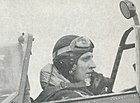
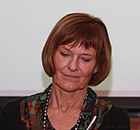
- Theodor Broch(1904–1998) a lawyer and politician, Mayor of Narvik 1934 to 1946, except during WWII
- Helge MehreMBEDSODFC(1911–1997) a Norwegian military officer
- Fredrik Kiil(1921–2015) a Norwegian physician, improved theartificial kidney
- Cissi Klein(1929 in Narvik – 1943 in Auschwitz) a Norwegian Jewish girl, victim of the Holocaust
- Dr.Jan Paulsen(born 1935) aSeventh-day Adventist Churchleader, past president of theGeneral Conference of Seventh-day Adventists
- Jack Berntsen(1940–2010) a Norwegian philologist, songwriter and folk singer
- Thorgeir Stubø(1943–1986) a jazz musician and composer, had a family of jazz musicians
- Terje Bjørklund(born 1945) a jazz pianist and composer
- Gro Brækken(born 1952) a businessperson, has chaired several public bodies
- Lise Haavik(born 1962) a Danish/Norwegian singer, sang at the1986 Eurovision Song Contest
- Anne Rydning(born 1965) Colonel in theNorwegian army,the first female Army chief in Afghanistan
- Vibeke Larsen(born 1971 in Vassdalen) a Norwegian Sami politician
Sport[edit]
- Per Willy Guttormsen(born 1942) a former speed skater, competed in the1964,1968and1972 Winter Olympics
- Thomas Hafstad(born 1974) a retired Norwegian footballer, 239 games forTromsø IL
- Ragnhild Gulbrandsen(born 1977) a journalist and former football striker with 80 caps forNorway
- Marit Røsberg Jacobsen(born 1994) a Norwegian handball player
Twin towns – sister cities[edit]
References[edit]
- ^"Navn på steder og personer: Innbyggjarnamn"(in Norwegian). Språkrådet.
- ^"Forskrift om målvedtak i kommunar og fylkeskommunar"(in Norwegian). Lovdata.no.
- ^Bolstad, Erik; Thorsnæs, Geir, eds. (26 January 2023)."Kommunenummer".Store norske leksikon(in Norwegian).Kunnskapsforlaget.
- ^Schanche, Tor Emil (22 September 2016)."Nå er denne byen endelig formelt" døpt "med et samisk navn".NRK Sápmi(in Norwegian).Archivedfrom the original on 23 September 2016.Retrieved19 September2017.
- ^Statistisk sentralbyrå(2020)."Table: 06913: Population 1 January and population changes during the calendar year (M)"(in Norwegian).Archivedfrom the original on 26 May 2020.Retrieved10 January2019.
- ^Statistisk sentralbyrå(2020)."09280: Area of land and fresh water (km2) (M) "(in Norwegian).Archivedfrom the original on 26 May 2020.Retrieved10 January2019.
- ^Jukvam, Dag (1999)."Historisk oversikt over endringer i kommune- og fylkesinndelingen"(PDF)(in Norwegian).Statistisk sentralbyrå.Archived(PDF)from the original on 1 September 2012.Retrieved7 June2012.
- ^Statistisk sentralbyrå(2012)."1805 Narvik. Population 1 January and population changes during the year. 1951–"(in Norwegian).Archivedfrom the original on 25 May 2012.Retrieved7 June2012.
- ^Karlsen, Tone Anita (22 August 2017)."Ny Narvik tar form".Harstad Tidende(in Norwegian).Archivedfrom the original on 11 September 2017.Retrieved10 September2017.
- ^ab"Civic heraldry of Norway - Norske Kommunevåpen".Heraldry of the World. 24 July 2022.Retrieved3 February2023.
- ^"Nytt kommunevåpen vedtatt".NRK Nordland(in Norwegian). 20 June 2019.Retrieved9 February2020.
- ^"Narvik, Nordland (Norway)".Flags of the World.Retrieved3 February2023.
- ^"Forskrift om godkjennelse av byvåpen, Narvik kommune, Nordland".Lovdata.no(in Norwegian). Norges kommunal- og arbeidsdepartementet. 1 June 1951.Retrieved3 February2023.
- ^Rygh, Oluf(1905).Norske gaardnavne: Nordlands amt(in Norwegian) (16 ed.). Kristiania, Norge: W. C. Fabritius & sønners bogtrikkeri. p. 285.Archivedfrom the original on 6 May 2016.Retrieved29 October2015.
- ^ab"Key facts about Narvik".VisitNorway.com.Archivedfrom the original on 20 September 2008.Retrieved24 November2008.
- ^ab"Narvik, Norway".BBC.Archivedfrom the original on 14 February 2009.Retrieved24 November2008.
- ^abcdChurchill, Winston S(1948).The Second World War: The Gathering Storm.Vol. 1. Cambridge: Houghton Mifflin.ISBN978-0-395-41055-4.
- ^Galland, Adolf(2001).The First and the Last.Cerberus Publishing. p. 92.ISBN978-0-89966-728-7.
- ^Hansen, Tore; Vabo, Signy Irene, eds. (20 September 2022)."kommunestyre".Store norske leksikon(in Norwegian).Kunnskapsforlaget.Retrieved14 October2022.
- ^"Kommunestyrevalg 2023 - Nordland".Valg Direktoratet.Retrieved27 December2023.
- ^"Tall for Norge: Kommunestyrevalg 2019 - Nordland".Valg Direktoratet.Retrieved27 October2019.
- ^abcd"Table: 04813: Members of the local councils, by party/electoral list at the Municipal Council election (M)"(in Norwegian). Statistics Norway.Archivedfrom the original on 19 April 2020.Retrieved10 January2019.
- ^"Tall for Norge: Kommunestyrevalg 2011 - Nordland".Valg Direktoratet.Retrieved27 October2019.
- ^"Kommunestyrevalget 1995"(PDF)(in Norwegian). Oslo-Kongsvinger: Statistisk sentralbyrå. 1996.Archived(PDF)from the original on 20 September 2014.Retrieved18 March2020.
- ^"Kommunestyrevalget 1991"(PDF)(in Norwegian). Oslo-Kongsvinger: Statistisk sentralbyrå. 1993.Archived(PDF)from the original on 22 May 2015.Retrieved18 March2020.
- ^"Kommunestyrevalget 1987"(PDF)(in Norwegian). Oslo-Kongsvinger: Statistisk sentralbyrå. 1988.Archived(PDF)from the original on 19 October 2014.Retrieved18 March2020.
- ^"Kommunestyrevalget 1983"(PDF)(in Norwegian). Oslo-Kongsvinger: Statistisk sentralbyrå. 1984.Archived(PDF)from the original on 19 October 2014.Retrieved18 March2020.
- ^"Kommunestyrevalget 1979"(PDF)(in Norwegian). Oslo: Statistisk sentralbyrå. 1979.Archived(PDF)from the original on 29 September 2014.Retrieved18 March2020.
- ^"Kommunevalgene 1975"(PDF)(in Norwegian). Oslo: Statistisk sentralbyrå. 1977.Archived(PDF)from the original on 15 March 2016.Retrieved18 March2020.
- ^"Kommunevalgene 1972"(PDF)(in Norwegian). Oslo: Statistisk sentralbyrå. 1973.Archived(PDF)from the original on 21 April 2016.Retrieved18 March2020.
- ^"Kommunevalgene 1967"(PDF)(in Norwegian). Oslo: Statistisk sentralbyrå. 1967.Archived(PDF)from the original on 21 April 2016.Retrieved18 March2020.
- ^"Kommunevalgene 1963"(PDF)(in Norwegian). Oslo: Statistisk sentralbyrå. 1964.Archived(PDF)from the original on 21 April 2016.Retrieved18 March2020.
- ^"Kommunevalgene og Ordførervalgene 1959"(PDF)(in Norwegian). Oslo: Statistisk sentralbyrå. 1960.Archived(PDF)from the original on 17 March 2016.Retrieved18 March2020.
- ^"Kommunevalgene og Ordførervalgene 1955"(PDF)(in Norwegian). Oslo: Statistisk sentralbyrå. 1957.Archived(PDF)from the original on 14 February 2020.Retrieved18 March2020.
- ^"Kommunevalgene og Ordførervalgene 1951"(PDF)(in Norwegian). Oslo: Statistisk sentralbyrå. 1952.Archived(PDF)from the original on 17 March 2016.Retrieved18 March2020.
- ^"Kommunevalgene og Ordførervalgene 1947"(PDF)(in Norwegian). Oslo: Statistisk sentralbyrå. 1948.Archived(PDF)from the original on 16 March 2016.Retrieved18 March2020.
- ^"Kommunevalgene og Ordførervalgene 1945"(PDF)(in Norwegian). Oslo: Statistisk sentralbyrå. 1947.Archived(PDF)from the original on 25 August 2014.Retrieved18 March2020.
- ^"Kommunevalgene og Ordførervalgene 1937"(PDF)(in Norwegian). Oslo: Statistisk sentralbyrå. 1938.Archived(PDF)from the original on 6 March 2016.Retrieved18 March2020.
- ^Svendsen, Oddvar (2002).Narviks historie(in Norwegian). Stiftelsen Narviks Historieverk.ISBN8299612829.
- ^"Første frostnatt – Yr".25 September 2013.Archivedfrom the original on 7 August 2021.Retrieved14 August2021.
- ^"Narvik daylight".Gaisma.com.Archivedfrom the original on 5 February 2012.Retrieved24 November2008.
- ^"EKlima".Archived fromthe originalon 28 January 2021.Retrieved1 February2021.
- ^"eKlima Web Portal".Norwegian Meteorological Institute. Archived fromthe originalon 14 June 2004.Retrieved6 June2012.
- ^abFouche, Gwladys (30 June 2008)."Sub-prime chill reaches the Arctic".The Guardian.Archivedfrom the original on 12 January 2017.Retrieved12 December2016.
- ^"Winter rail destinations: Narvik".SJ AB.TheLocal.se. 3 November 2008.Archivedfrom the original on 7 November 2008.Retrieved8 November2008.
- ^Stensvold, Tore (30 October 2015)."Nå skal de suge fast skipene til kaia".Teknisk Ukeblad.Archivedfrom the original on 1 March 2020.Retrieved18 April2016.
- ^Valle, Marius (21 April 2016)."Elon Musk: - Derfor har ikke Tesla satset på hydrogenbiler".Teknisk Ukeblad.Archivedfrom the original on 22 April 2016.Retrieved21 April2016.
Our most important individual customer lives in Narvik, he has bought a number of Teslas, and lets people in town use them at will.
- ^"Narvik Krigsmuseum".Visit Narvik AS.Archivedfrom the original on 26 September 2017.Retrieved1 September2017.
- ^"New war museum in Narvik".11 April 2016.Archivedfrom the original on 27 April 2016.Retrieved11 April2016.
- ^Bjørn Cappelen."Paul Due".Store norske leksikon.Archivedfrom the original on 26 September 2017.Retrieved1 September2017.
- ^"6 ting du kanskje ikke visste om Narvik".fordeby.no(in Norwegian). FørdeBy. 16 January 2020.Archivedfrom the original on 7 February 2020.Retrieved31 January2021.
External links[edit]
- Municipal fact sheetfromStatistics Norway(in Norwegian)
- Museum Nord Official Website
- Narvik Krigsmuseum Official Website
 Narviktravel guide from Wikivoyage
Narviktravel guide from Wikivoyage- Destination Narvik – tourist information(in Norwegian)




